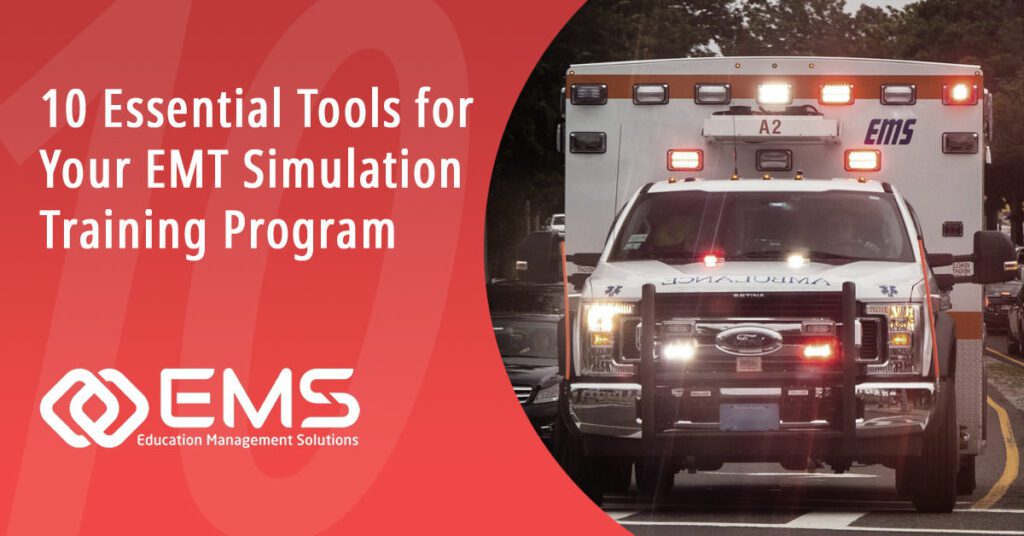Emergency Medical Technicians (EMTs) operate in dynamic and high-pressure environments where proficiency and competence are crucial. Because the ability to operate under these demanding conditions comes with the job, effective training for EMTs is foundational to the entire profession. Proper training equips critical responders with the essential knowledge and skills needed to effectively manage emergencies.
Simulation-based training is an increasingly employed component of effective training programs for Emergency Medical Services professionals. Simulations’ realistic and interactive qualities can prepare EMS personnel for a wide variety of scenarios they will encounter in ways traditional classroom instruction cannot. Furthermore, hands-on simulation training can play a role in developing decision-making and critical-thinking skills among EMS professionals. Faced with simulated scenarios, EMS students learn to rapidly assess situations, gather information, and make informed decisions about appropriate actions, preparing them for the unpredictable nature of real-world medical emergencies.
The Best Tools for EMT Simulation Training
But what are the most beneficial pieces of a successful simulation program geared toward EMT training? When looking at which simulation solutions you should deploy for your program, consider utilizing the following tools:
1. High-Fidelity Simulators:
Manikins that mimic human physiological responses such as bleeding, breathing, and vocalization, allows trainees to practice skills such as CPR, airway management, and trauma assessment.
2. Virtual Reality (VR) Simulations:
VR can immerse EMT trainees in a nearly limitless array of scenarios, ranging from routine calls to mass casualty incidents.
3. Comprehensive Scenario Libraries:
A robust library of potential scenarios including medical emergencies, trauma, childbirth, pediatric emergencies, and more, ensures trainees have a wide-ranging experience.
4. Debriefing Tools:
EMS simulation software that can record and playback training scenarios for detailed debriefing sessions, where instructors can give detailed feedback on performance.
5. Portable Simulation Recording and Debriefing System:
For on-the-go training, mobile debriefing solutions can be brought to the trainees’ location, offering flexibility and realism outside of the classroom setting.
6. Interactive Assessment Tools:
Online or standalone software that provides interactive case studies, quizzes, and learning modules is particularly useful for skill development and retention.
7. Augmented Reality (AR) Training Tools:
AR can provide visual overlays on practice manikins or real-world environments to enhance the learning experience during skill acquisition.
8. Live Actor Programs:
Managing live actors help EMTs practice communication skills, patient assessment, and response to emotional and psychological conditions during emergencies.
9. Integration With Real Equipment:
Solutions that can incorporate the use of actual medical equipment and devices (e.g., defibrillators, splints) increase the realism of training and smooth the transition to real-life operations.
10. Monitoring and Student Progression Tracking Tools:
Competency tracking software allows instructors to track trainee progress across various competencies and skills. It provides detailed insights into individual performance, highlighting strengths and areas for improvement.
How to Build Your Ideal EMT Simulation Training Program
An ideal solution for EMT simulation training is often a complimentary blend of a variety of the tools listed above that more precisely meet a program’s needs and scale. By finding the right mix of tools to employ, training programs can be tailored to meet the specific learning objectives and budgetary constraints of each EMT training organization.
Education Management Solutions (EMS) recognizes the critical nature of preparation for these frontline professionals. Our simulation training software is engineered to help provide EMS learners and their instructors with an immersive, lifelike learning environment that effectively bridges the gap between theoretical knowledge and practical skills. From mobile simulation platform, such as our Training in Motion platform, to our Competency Management software, EMS has a solution that is the right fit for any Emergency Medical Services’ simulation-based training program.
Schedule a discussion with one of our solutions experts today.

